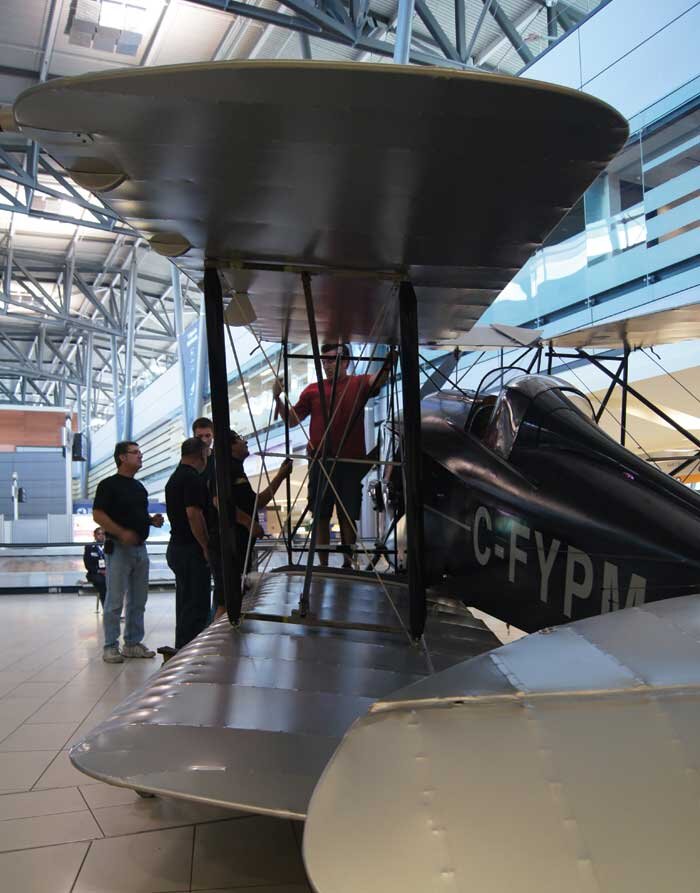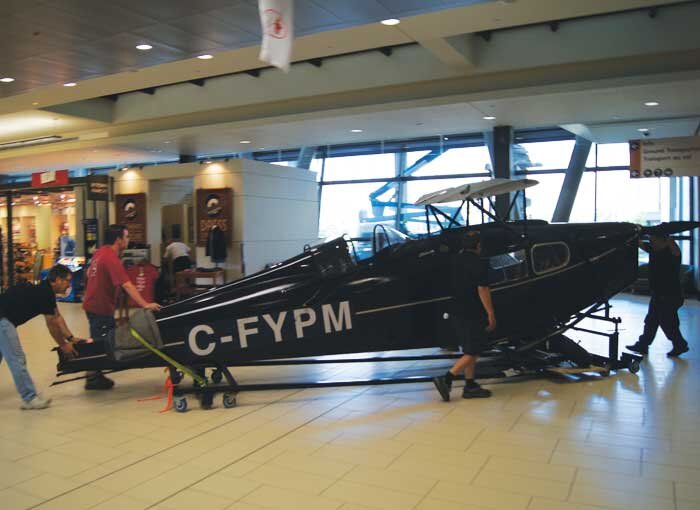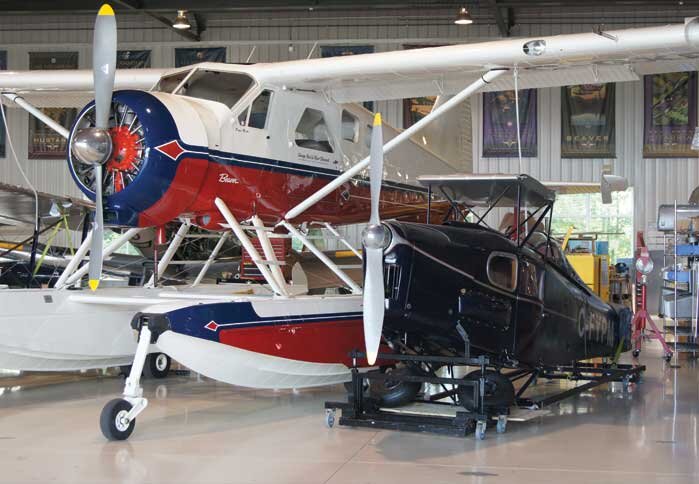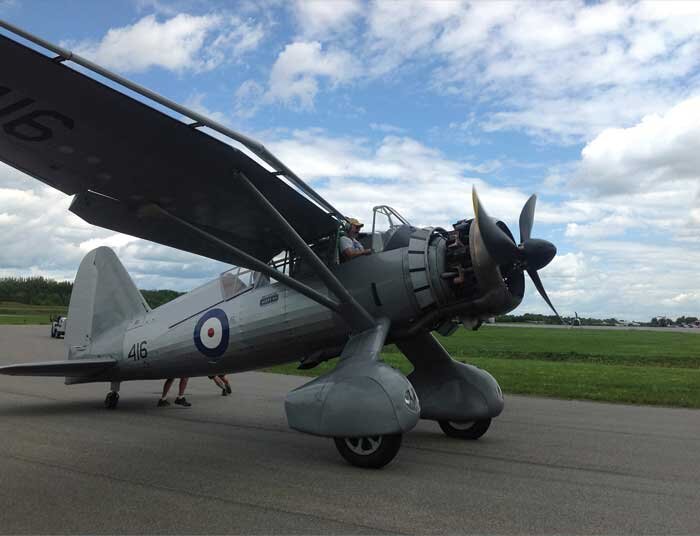JUST WINGIN’ IT
To the west went the Discovery Air Hawk One Sabre, the Robillard Brothers Mustang IV and the Warrant Officer Harry Hannah Stearman. To the east went the four Yellow Wings aircraft – the Finch, Tiger Moth, Harvard and Cornell. These seven aircraft have done yeoman service throughout the summer, telling the stories of Canada's heroes and recruiting new Vintage Wingers from British Columbia to Prince Edward Island. With the Vintage Wings of Canada flying season in full swing and the hangar more roomy, it was time to put maximum effort into the restoration projects on the hangar floor. All available hands, both staff and volunteers, were pressed into service to speed up the Hawker Hurricane XII project while work continued unabated on the Supermarine Spitfire IX wing rebuild. As well the Roseland Spitfire team in Comox made huge strides on the fuselage in their new expanded facility. Things are beginning to turn around on all fronts.
We thought you would like to see what is happening down on the hangar floor while the deployed aircraft are flying overhead this great land.
The Flying Officer William McKnight Hawker Hurricane XII
Sadly, this summer, the warbird restoration legend Harry Whereatt passed away in Saskatchewan. Our Hurricane XII was purchased from Harry five years ago and it would have been a wonderful thing for him to see it fly again. For these past years, work on the project has been stop and go as labour has been focused on our flying aircraft and other restorations such as the Fairchild Cornell and the Westland Lysander. Despite the lurching forward, progress has been made and this summer, the empennage, engine mounts, landing gear and centre section came together. Last year, the wings that Harry had built came back to us after major repair work was completed by Steve Martin in Southern Ontario, readying the wings for further work here in Gatineau.
Vintage Wings of Canada will add some reinforcement to these wings to accommodate additional fuel tanks and associated plumbing. In the meantime, the wings were hoisted into place and attached to the centre section to test fit and alignment. Everything was perfect!
Now, work continues on the Hurricane and our long term goal is to roll out the finished Hurricane at next year's Wings over Gatineau-Ottawa en vol air show. Stand by for more updates throughout the year as we get closer to this historic flight.
The Flying Officer William Lidstone McKnight Hawker Hurricane XII up on jacks with wheels and wings attached for the first time in five years. The restoration team, lead by Andrej Janik and Paul Tremblay was checking fit and alignment on the wings which had been repaired by Steve Martin of Hamilton, Ontario. These wings were delivered a year ago and had yet to be attached. The fit was perfect, the mechanics happy. Photo by Dave O'Malley
The complexity of the Hurricane's structure can be clearly seen in this shot – a web of tubes and tension connections combined with cabinet work, beneath an outer skin that for most people looks similar to the Spitfire, but is truly a structure from another era. Photo by Dave O'Malley
A close-up of the wing showing the fabric covering of the four machine gun ports on the starboard wing. This is a permanent installation, but during the Second World War, these ports would have been covered over after each mission with red tape, prior to the next mission. In With Wings like Eagles, author Michael Korda explains why gun tape was used, “In order to prevent moisture (rain or fog) from entering the open gun ports in the wing and freezing on the gun breeches as the plane took off and climbed rapidly into the colder air, Dowding [Air Chief Marshal Hugh Dowding, commander of Fighter Command during the Battle of Britain} had the ground crews cover the gun ports with “sticky tape”, very much like what is now called duct tape. That used by the RAF was bright red, hence the bright red patches on the leading edge of the wings of British fighters. The first bullet simply cut a hole in the tape. Armorers usually left taping over the gun ports to the last, after they had cleaned and reloaded the guns, so the intact red patches were a sign that the fighter was ready for action again.” Photo by Dave O'Malley
Related Stories
Click on image
Smooth on the outside, complicated and bumpy on the inside. With our view up inside the fuselage structure of the Hurricane, we see the head-scratching complexity of the tubular structure and attendant cross-bracing. The wing centre section box spar of the Hurricane's wing can be seen at the bottom of the fuselage running horizontally. Photo by Dave O'Malley
A close-up of the wing centre section where it attaches to the fuselage and the firewall. Photo by Dave O'Malley
Part of the team working on the Hawker Hurricane XII project: Back row (L-R) Terry Cooper, Jim Luffman, and Ron Johnson. Front: (L-R) Eden Peruzovic and Paul Tremblay. Photo by Dave O'Malley
A look at what the Flying Officer William Lidstone McKnight Hurricane XII will look like when it is done. McKnight's famous Grim Reaper fuselage artwork will make this aircraft a much photographed subject in the years to come. Digital image by Shado at airwarfare.com
A close-up view of the unique and famous Grim Reaper fuselage art of the Hurricane that was flown by Canada's Flying Officer Willie McKnight. When this aircraft is in the air again, it will tell the remarkable story of one of Canada's greatest, yet long forgotten heroes. Digital image by Shado at airwarfare.com
The Flight Lieutenant Arnold Roseland Supermarine Spitfire IX
We thought we would be much, much further ahead on our Roseland Spitfire project by now, but from the outset, we have been plagued by problems and challenged by two major setbacks that killed forward progress for many months, if not for years. The first delay of major consequence was that much of the fuselage work and tail assembly work that had been done before we took responsibility for the project was either improperly done or undocumented. This required more than a year of work to address and only this winter did we get back to the point we thought we were when responsibility fell to us – square one. But since then, the experienced Vintage Wings team at Comox, in its newly expanded facility, has made significant headway on the project and has turned it around.
In addition, theY2-K project, as it was then known, had begun a relationship with British metal fabrication company and Spitfire “experts” Hull Aero to build a pair of Mark IX wings. We thought it would be best if we continued with the relationship with Hull to keep things running smoothly as we had a lot of public relations issues to deal with at the outset of our stewardship of this project. That was our biggest mistake.
Over the next 18 to 24 months, every effort was made to work with this contractor to ensure our work was on track. We believed and trusted that they were the experts and as such we wanted to show them the utmost in respect – as we do with all our contractors. But after repeated attempts to speak with Hull, visit their facility and review the progress of the work were met with stonewalling, avoidance and a total lack of communication, we knew something was seriously wrong.
Finally we reached the point where we demanded our wings be returned. It was upon receipt and detailed inspection of those wings that our worst fears were confirmed. There was a total disconnect between the funds paid and the progress made, and in fact, much of the “progress” was not progress at all. One wing was about 75% complete, while the other was 25% finished. Regardless of the degree of completion, the wings were dead wrong. Opening up the wings we discovered that the spars were not for a Mark IX but rather a Mark I, and that considerable work had been done to force-fit interior structural components to make it work for a Mark IX. The spars themselves were originally drilled out for Mark I standards. Our landing gear components would not even line up with the holes that were drilled. If we drilled even more holes to make them fit the structure would have been compromised. In addition, there were other holes drilled in the main spars that did not fit any of our equipment and rendered the spars scrap metal as per Supermarine's strict structural recommendations. There were components which were made from steel when they should have been aluminum. The work was unacceptable.
What to do? Thanks to respected Spitfire structural expert Ian Ward of VMI Engineering Services, who came over from England to execute a detailed assessment of the shoddy work done on the wings, we were able to make a plan to move forward, which unfortunately involved some big steps backward.
The first thing we did was purchase another set of Spitfire wing spars in England and have them shipped here as we no longer trusted Hull to do the work properly. If we were to rebuild a set of Mark IX wings, it would be smart to start with the proper foundation –something Hull did not think to do. The spars were loaded onto a ship which got almost halfway across the Atlantic when engine problems forced it back to Antwerp for repairs. Weeks later, with the problems solved, the ship then ran up against a dock workers strike in the Belgian port. Our star-crossed wings were stranded for yet another week or so. By this time we were pulling our hair out back in Gatineau.
Finally, they arrived in the spring and much measuring was done before the first hole was drilled in these rare and very costly structural members. Since then, master metals specialist and fabricator Ken Wood and fellow Vintage Wings technicians have been working, steadily trying to undo the damage done by these “experts”. Wood says that the wing that was 75% complete was far more time consuming to rebuild as he had increased work trying to remove, repair, rebuild and re-install components that were part of the abortion created in the name of restoration. The wing which was 25% complete has proceeded at a more rapid pace, thanks to the fact that we had less damage to repair.
Take a look now at the work being done on the wings at Gatineau, where pride of workmanship and reputation are foremost.
A close up look at the Arnold Roseland Spitfire IX “D-Box”, the leading edge structure forward of the main spar. Photo by Dave O'Malley
Another look at the “D-Box” of the Spitfire wing. Some components for this complex wing shape were salvaged from Hull Aero's botched work, while others completely rebuilt to connect with the new spars which were ordered when we saw the mess that was delivered. When we took receipt of these wings, one wing was perhaps 75% completed (though not using spars drilled for Mark IX specs) and the other wing was approximately 25% complete (and wrong also). As it turns out, it is easier to repair the wing that was less complete as we could do most of the work ourselves. The wing that was more complete required far more attention to undo the damage, construct new components where necessary and rebuild. If only we had known! Photo by Dave O'Malley
The landing gear attachment points of the port wing. When the wings arrived from Hull Aero, the holes drilled for the pintle (angled component at right) were in the wrong location, appropriate for a Mk I wing and not the Mk IX wing ordered. Drilling new holes would have weakened the structure, so this meant rebuilding the whole assembly. Photo by Dave O'Malley
A week later, we see the landing gear pintle and the up-down locking mechanism attached to the wing structure. Photo by Dave O'Malley
In order to have access to all sides of both wings at the same time Vintage Wings contracted to build a walk-in self-lit master jig, to which we could attached components as required. Here, apprentice Ian McKenzie stops his work to humour the photographer. Photo by Dave O'Malley
It takes a lot of sophisticated tools, jigs and experience to build a Spitfire wing. It also takes a lot of simple tools like a ball peen “persuader” and a load of time. Here we see a close up of the area where the landing gear and up- and down-lock is attached. Photo by Dave O'Malley
Apprentice AME Ian McKenzie works on access ports for the D-Box structure. Ian is lucky to be working under the tutelage of Ken Wood, a highly experienced metals and structures man... a rock star in the world of metal fabrication in Canada. Unlike Hull Aero, Wood, McKenzie and the others working on this project care about the quality of the work that they do. Photo: Dave O'Malley
Standing in the wing jig, Ian McKenzie (L) and master metal fabricator Ken Wood take a moment from their labours to pose for the writer next to a D-Box bristling with “cleco” fasteners holding the wing's skin temporarily to the frame. Clecos are small clamps that replace rivets for temporary alignment and fastening. Photo by Dave O'Malley
When the wings are finished in Gatineau, they will travel to Comox where they will be attached to the finished fuselage of the 442 Squadron Spitfire IX, which is dedicated to the memory of Flight Lieutenant Arnold “Rosey” Roseland, a gifted flight leader who lost his life over France in 1944. Roseland's logbook indicates he flew a similar Spitfire IX with the Y2-K letter code on the side more than 65 times. Photo is an altered image by Gavin Conroy, with additions of the 442 Squadron markings and image of Roseland in the cockpit by Dave O'Malley
A close up of the altered Gavin Conroy photo shows Arnold Roseland in the cockpit. Photo is an altered image by Gavin Conroy, with additions of the 442 Squadron markings and image of Roseland in the cockpit by Dave O'Malley
The Prince of Wales de Havilland DH-83 Fox Moth
While we are not actually building, rebuilding, restoring or even overhauling anything on the Fox Moth, it is interesting to see how we moved her from her temporary home at the Ottawa International Airport back to the Vintage wings hangar where she will remain for the near future. the Fox Moth is now owned by Blake Reid, one of our pilots, who will continue to operate this historic aircraft at Gatineau. What follows is a photographic record of what it takes to move a historic aircraft without the aid of flight.
For nearly a year, the Vintage Wings of Canada DH-83 Fox Moth has been displayed along with VWC information banners near the baggage claim carousels at the Ottawa International Airport courtesy of Ottawa International Airport Authority CEO Paul Benoit. Arriving passengers and waiting families could get a good look at a piece of British and New Zealand history. Photo Alan Shafto
The Fox Moth's elegant wing pairings can fold backward to allow for storage in some pretty tight spaces, but this was not, unfortunately, compact enough to allow us to roll it through the large doors of the Ottawa International Airport without first removing the wing sets. Photo Alan Shafto
Ian McKenzie starts the removal of the port wing pairing. Photo Alan Shafto
With the port wings removed and attached to their rolling transport jig, the team addresses the starboard set. Photo Alan Shafto
From high above, Alan Shafto captures the nearly disassembled Fox Moth. All that is left to do is collapse the gear and remove the empennage or tail assembly. The airport kindly supplied security staff to guard against the overly-curious. Photo Alan Shafto
The crew walks the wingless and tailless fuselage of the Fox Moth towards the east side doors of the terminal. Photo Alan Shafto
Out the doors and right up onto the tilting flat bed trailer. Photo Alan Shafto
With the fuselage and the two wing sets lashed down well, the tractor and float make their way slowly and carefully through downtown Ottawa and across the river to Gatineau. Photo Alan Shafto
The rig carrying the disassembled Fox Moth rounds the corner of Rideau Street and King Edward Avenue. Photo Alan Shafto
Home again after a year long stay at the Ottawa Airport, the Fox Moth enters the ramp outside of the Vintage Wings hangar. Photo Alan Shafto
Guy Richard, head of maintenance at Vintage Wings, stands on the float as the large components are readied for off-load. Photo by Dave O'Malley
The engineers, apprentices and technicians at Vintage Wings of Canada all work for a separate entity known as Vintech Aero. Vintech is a group of Canada's finest aircraft maintainers and restorers, known for their skill and their attitude, as displayed by this shirt, worn by metal fabricating rock star Ken Wood. Photo by Dave O'Malley
Off comes the first wing set, lowered with great caution down the ramp of the tilting flat bed. Photo by Dave O'Malley
Australian volunteer, pilot, mechanic, and aviation management student, Alan Shafto has taken a month off from his studies at the University of Western Ontario's Commercial Aviation Management Program to provide enthusiastic and knowledgeable support leading up to our Wings over Gatineau en vol air show (on the weekend of September 15-16th). Here Shafto anchors the starboard wing set as the team gets set to lower it to the hangar floor. Photo by Dave O'Malley
Looking more like a strange road vehicle than an elegant flying machine, the fuselage is readied to be lowered. Photo by Dave O'Malley
Technician Eden Peruzovic strains to hold back a too-rapid off-loading of the fuselage. The rare aircraft was handled with extreme car throughout the move. Photo by Dave O'Malley
Home at last... and safe. The fuselage of the little de Havilland Fox Moth sits under the wing of its younger and much bigger bush plane brother, the de Havilland Canada DCH-2 Beaver. Photo by Dave O'Malley
The Sergeant Clifton Stewart Westland Lysander
Though the wings on the Sergeant Cliff Stewart Westland Lysander are working just fine (WE restored them), the brakes are definitely not. The touchy and anemic pneumatic braking system has been a source of frustration and consternation since the first flight. Last week, test pilot Rob Erdos was brought in to test the recently inspected Bristol Mercury engine and while he was running it up, he also taxied for a bit to test the brakes. They did not fail to disappoint. So weak is the system, that mechanics Angela Gagnon and André Laviolette (you can just make out their legs under the fuselage) had to push the tail round the bend of the taxiway as the “Lizzie” couldn't even make the corners. Photo by Dave O'Malley
Having pushed the “Lizzie's” tail round the bend, Laviolette was in front of the tail plane when the aircraft began taxiing. As a result, he had three options to keep himself from being hit... jump out of the way, roll underneath, or simply sit on the tail and go along for the ride. Photo by Dave O'Malley
“Engine's fine,” says Erdos, “ just a couple of tweaks, but the brakes... not so great”. Situation normal. Photo by Dave O'Malley









































